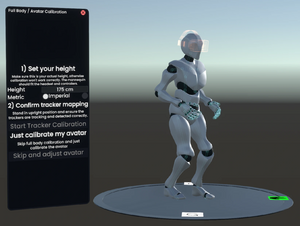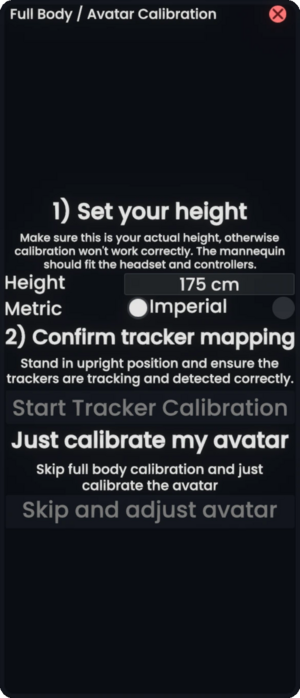
Full Body Tracking allows the user to be more immersed in VR within Resonite by controlling the avatar's limbs using a form of tracking (physical devices or cameras) that modifies the user's IK bone positions based on positions provided by the host VR runtime.
Full Body Options
Vive Trackers or Tundra Trackers
Both Vive trackers and Tundra trackers when using SteamVR are recognized by Resonite. They are plug and play, and require no additional setup other than their respective pairing and setup for SteamVR.
Slime VR
(TODO: Explain how to setup full body with Slime VR, and where to get them)
MediaPipe
(TODO: Explain how to setup full body with MediaPipe, and where to get it)
Full Body Calibration

Full Body Calibration should be done through the full body calibrator. Doing it through settings menu is not recommended as doing so makes the system pin the user randomly and is hard to use.
Places To Calibrate
Calibration in general is hard to do in someone else's world or a headless. This is due to the grab points using Sliders, which by default have dont drive disabled. When the Slider is grabbed with this option disabled, it makes the movement localized until release. Unfortunately the release mechanism is entirely inaccurate and drops the slider where the host sees it instead of the local user. Causing massive headaches and frustration. To fix this, simply use a dev tool to change the DontDrive toggle to true, or optionally use a mod so this is done automatically, or go to your home world to calibrate. This is a known issue.
Why There is two Calibrators
The calibrator works on a 2 reference basis. There is the User Calibration Reference and the Avatar Calibration.
The point of this two step system is to allow for instant switching of avatars without readjustment. Other VR games often require recalibration every avatar switch.
For example, User A has their hip tracker on the back of their hips, and user B has their hip tracker on the front of their hips. Both users calibrate their User Calibration Reference to fit their real life bodies exactly. User A then equips a full body calibrated avatar from a public folder. User B also equips the same avatar from the public folder.
The avatar now fits both users the exactly the same. Since we know the Avatar is designed for full body, the avatar will fit both users even if they have different tracker positions. If there wasn't a User Calibration Reference, one of the users would need to adjust the avatar and then save their own copy, taking precious inventory space.
This allows users to calibrate avatars for full body, and share them easily. The only downside however; is when a user changes their tracker positions, they need to recalibrate their User Calibration Reference.
User Calibration Reference
The first reference is called the "User Calibration Reference" this is also referred to as the invisible man, or the orange figure. The User Calibration reference is edited via using the "Start T-Pose calibration" or using the adjust manually option. This is saved automatically and is tied to your account/settings.
The User Calibration Reference needs to fit your real life body as best as possible. All avatars in the game when Full Body calibrated will essentially be in the exact same spot as this reference. Move the reference objects to create the rotation and position offsets from your tracker, so the User Calibration Reference fits your real life body as closely as you can.
Tracker mapping for the user is based on proximity to the User Calibration Reference T-pose visual during T-Pose. The user may need to walk in their physical play space to center themselves on it. If this method is not cooperating, the user can manually assign trackers to body nodes in the Settings menu. Only a few nodes are supported. For example, fingers dont work as tracker points (And wouldn't make sense anyway).
Avatar Calibration
This only has to ever done once to an avatar and then saved. When calibrating an Avatar, the body of the avatar needs to fit the User Calibration Reference as closely as possible, and not the user themselves. If the avatar has strange proportions, getting it to fit in a way that feels right and matches as closely as possible to the User Calibration Reference is the goal. The avatar calibration is represented by the transforms of the Target slots under the Proxy slots in the avatar object itself. The avatar has to be saved as an item for the changes to save!
(TODO: pictures!!!)
Post Setup
When done, the user will not need to save if they just calibrated their User Calibration Reference. However, if the avatar they are wearing needed to be adjusted due to never having been set up as a full body avatar, the avatar will need saving.
If the avatar needed adjusting despite being a full body calibrated avatar, please return to User Calibration Reference and adjust the User Reference to fit instead either manually or Via T-pose.
When Finished Using Full Body Tracking
There is an in-platform way of disabling trackers, located in the Dash Menu, in the settings tab, then going to devices and scrolling down to "Tracker Settings" and then toggling "Use Trackers". This is a global setting that effects all worlds you are in or will be in (and may need to be toggled once more to use Full Body Tracking again).
Community Tools
There is a community tool called the Feetus Deletus that removes the slots that your IK or proxies are following on your avatar. Allowing the user to use VR regularly again without the tracking.
There is a community Context menu addon called the FBT Killer that allows you to disable full body tracking with a push of a button. The added advantage is having this installed along with your avatar allows you to have the convenience of disabling the feature for the current world only but not for other worlds.
These tools only effect you in the current world you are in, as joining or starting another world would bring back the issue.
Common Issues
Oculus runtime users
Run Resonite in SteamVR mode, either with the -SteamVR Command Line Arguments.
Otherwise Resonite will run just fine, but no trackers will show up.
Trackers
Trackers can lose connection, either by running out of batteries or being too far from a receiver or listener. When this happens, the tracker on your Avatar will freeze in place until the tracker is able to be turned back on or is within range again. Also disabling the tracker via the Settings menu will unpin the body part being controlled. The body part will behave as if it never had a tracker in the first place.
Camera Tracking
(TODO: What to do when camera tracking fails.)
Side Effects
Here is a list of side effects that you may run into when using (or not using) full body tracking:
- When scaling and you have your trackers plugged in to charge and are recognized in Resonite, you will no longer scale at the center of yourself, but the center of your play space (more evident when the trackers are across the room from where you are).
- The hip tracker has dominance over everything instead of the head. Meaning it can pull your world space hands away from your dash menu world hands. If this is done slightly, certain angles will force your lasers in your dash space to your avatar hands. This can make the menu hard to control.